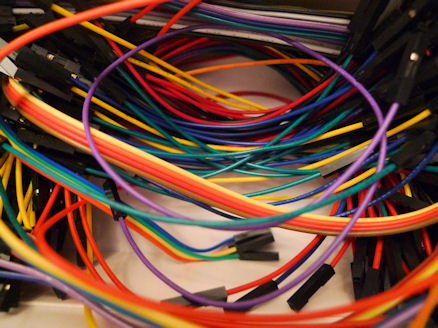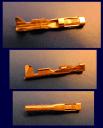Like it or not, the 0.1 inch spaced (2.54mm) header pins or sockets on PCBs are extremely common. There are also 2mm spaced alternatives, but they are still uncommon.
Making up 0.1 inch connectors is a minefield; it can be extremely difficult finding matching housings and the crimp terminals (pins or sockets) that fit them. Pre-built wires with connectors are available from sparkfun at a reasonable price. (Search the site for ‘premium jumper’; they are in several lengths and Male-Male (i.e. pin-pin), Female-Female (socket-socket) and Male-Female combinations).

Technically just the Female-Female cables are sufficient, because whenever Male is needed, they can be adapted by SIL pins like these:
Nevertheless, it is still occasionally important to build your own custom cables.
This is an attempt to document some 0.1 inch housings and crimp terminals that work together. I will group them into working collections (and also show images so that the different ones can be visually identified too. Click on the images to enlarge). For example, any housing in group ‘A’ will fit any crimp terminal in group ‘A’. If you know of additional terminals/housings that work with the groups below, let me know in the comments field. Or if you have a new group to suggest.
Housings group A
There are some generic Farnell (Multicomp) available (search for ‘2226A’ on the Farnell site). They are fairly low cost and very good value. They are available in 2,3,4,5,6,8,10,12,14,18,20,22,24 way. Note that 1-way is not available in this range.
Single-way housings (and in fact some other sizes too, and pre-built cables) are available from ebay, and they appear visually identical to the Farnell ones. Search for ‘Dupont jumper’. They are extremely low cost.
Note that the Sparkfun and Adafruit pre-assembled premium jumpers also visually appear to use the same housings.
Crimp sockets group A
The low cost Farnell (Multicomp) type 2226TG is a good choice; it is very economical. It was out-of-stock and awaiting delivery the second time I checked, however.
It can be found that crimp sockets which are likely compatible are also available from ebay (search for ‘Dupont jumper’ but they tend to be non-plated with gold. The Farnell 2226TG type are partially gold-plated (i.e. at the contact end).
Housings group B
TE Connectivity ‘AMPMODU MOD IV’ socket housings are available in every size from 1 to 36 way. Their part numbering is in two variants, where one variant is stamped with white print, and the other isn’t (see the photo. Not all sizes are available in both variants). The TE part code for the single way housing is 7-87499-2 (Farnell 1625135). They are not particularly cheap (£0.50 each).
Crimp sockets group B
TE Connectivity 6-87756-8 (Farnell 1183428) is a partially gold-plated contact. Looking at it length-ways, notice the location of the hook is at the back of the terminal (the front being the open side).
Take a look at TE Connectivity 1-104480-6. It is a gold-plated socket, and is in the AMPMODU (not AMPMODU MOD IV) range. Note the unusual shaped hook. Also, notice that the hook is on the front side of the terminal. However, it still fits the AMPMODU MOD IV sockets, if the socket is rotated 180 degrees about it’s axis.
Crimp tools
Unsurprisingly, good crimp tools cost a lot. The Fry’s Electronics tool #1922790 (Philmore WS26) is intended for D-sub crimp terminals, but it works fairly well for the crimp terminals mentioned above. The tool costs less than $10.
Here is an image of a 10/0.1 wire crimped to a TE Connectivity 1-104480-6 socket. The wire was stripped by a few millimeters and then crimped. Notice that the insulator is well crimped and does not move even with some force, but the conductor is loose.
The conductor would have been well crimped if the wire was thicker, or if the wire had been folded over. Personally, I tend to first tin the wire with solder (this was not done for this photo) and then crimp it, and then gently heat the terminal and apply a little solder near the cut wire end. If this is done quickly, the insulation does not melt, and no solder flows into the contact portion. There are differing schools of thought on this, but for personal use I find it adequate.
Wire
Some people use 7/0.2 wire (7 strands of 0.2mm diameter), others use 10/0.1. The former can handle more current. Personally I prefer 10/0.1 (it is slightly thinner). It is obtainable in short lengths and various colors from eBay. It is quite expensive buying short lengths. It is far cheaper to buy from Rapid Electronics in larger 100 meter rolls




